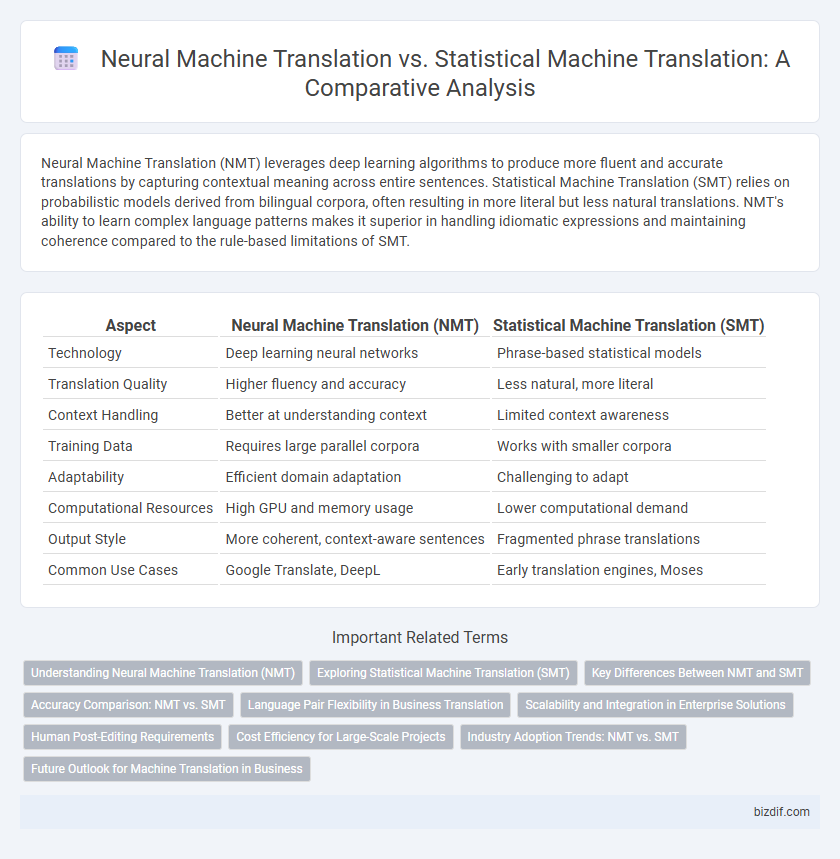Neural Machine Translation (NMT) leverages deep learning algorithms to produce more fluent and accurate translations by capturing contextual meaning across entire sentences. Statistical Machine Translation (SMT) relies on probabilistic models derived from bilingual corpora, often resulting in more literal but less natural translations. NMT's ability to learn complex language patterns makes it superior in handling idiomatic expressions and maintaining coherence compared to the rule-based limitations of SMT.
Table of Comparison
| Aspect | Neural Machine Translation (NMT) | Statistical Machine Translation (SMT) |
|---|---|---|
| Technology | Deep learning neural networks | Phrase-based statistical models |
| Translation Quality | Higher fluency and accuracy | Less natural, more literal |
| Context Handling | Better at understanding context | Limited context awareness |
| Training Data | Requires large parallel corpora | Works with smaller corpora |
| Adaptability | Efficient domain adaptation | Challenging to adapt |
| Computational Resources | High GPU and memory usage | Lower computational demand |
| Output Style | More coherent, context-aware sentences | Fragmented phrase translations |
| Common Use Cases | Google Translate, DeepL | Early translation engines, Moses |
Understanding Neural Machine Translation (NMT)
Neural Machine Translation (NMT) leverages deep learning models, particularly recurrent neural networks (RNNs) and transformers, to generate more fluent and contextually accurate translations compared to Statistical Machine Translation (SMT). NMT processes entire sentences as sequences, capturing long-range dependencies and semantic nuances that SMT's phrase-based methods often miss. By continuously improving through large training datasets and end-to-end learning, NMT achieves superior performance in handling ambiguity and idiomatic expressions.
Exploring Statistical Machine Translation (SMT)
Statistical Machine Translation (SMT) relies on probabilistic models and large bilingual corpora to generate translations by analyzing the frequency and patterns of word and phrase alignments. SMT systems use algorithms like phrase-based or syntax-based models to statistically infer the most likely translation from source to target language. Despite being largely surpassed by Neural Machine Translation in fluency and context understanding, SMT remains valuable for its interpretability and efficiency in domain-specific translation tasks.
Key Differences Between NMT and SMT
Neural Machine Translation (NMT) employs deep learning models that generate more fluent and context-aware translations by processing entire sentences as sequences, unlike Statistical Machine Translation (SMT), which relies on phrase-based probabilities and rule-driven algorithms. NMT systems adapt better to language nuances, idiomatic expressions, and long-range dependencies, achieving higher accuracy and naturalness in output. SMT often requires extensive feature engineering and struggles with context sensitivity, making NMT a more scalable and efficient approach for large-scale multilingual translation tasks.
Accuracy Comparison: NMT vs. SMT
Neural Machine Translation (NMT) demonstrates significantly higher accuracy compared to Statistical Machine Translation (SMT) by leveraging deep learning models that capture broader contextual information and semantic nuances. NMT systems reduce common errors associated with phrase-based SMT, such as disfluencies and awkward phrasing, by generating more fluent and coherent translations through end-to-end training. Evaluation metrics like BLEU scores consistently show NMT outperforming SMT across diverse language pairs, confirming its superior translation quality and reliability.
Language Pair Flexibility in Business Translation
Neural Machine Translation (NMT) offers superior language pair flexibility compared to Statistical Machine Translation (SMT), enabling businesses to efficiently translate diverse multilingual content with higher accuracy and naturalness. NMT models leverage deep learning to capture context and nuances across less common or complex language pairs, reducing the need for extensive parallel corpora that SMT relies on. This adaptability accelerates global communication and localization efforts, making NMT the preferred choice for business translation across varied linguistic markets.
Scalability and Integration in Enterprise Solutions
Neural Machine Translation (NMT) demonstrates superior scalability by leveraging deep learning models that continuously improve with increased data, enabling seamless integration into diverse enterprise solutions through APIs and cloud platforms. In contrast, Statistical Machine Translation (SMT) often requires extensive manual tuning and struggles to scale efficiently, limiting its adaptability within complex business environments. Enterprises benefit from NMT's ability to handle nuanced language patterns and automate updates, ensuring robust and scalable translation workflows.
Human Post-Editing Requirements
Neural Machine Translation (NMT) produces more fluent and contextually accurate translations, reducing the overall human post-editing effort compared to Statistical Machine Translation (SMT). However, NMT outputs sometimes contain subtle errors that require specialized linguistic expertise for effective correction. In contrast, SMT typically demands more extensive post-editing due to its reliance on phrase-based patterns and limited contextual understanding.
Cost Efficiency for Large-Scale Projects
Neural Machine Translation (NMT) significantly reduces operational costs for large-scale projects by leveraging deep learning models that require less human intervention and produce higher-quality translations, minimizing post-editing expenses. In contrast, Statistical Machine Translation (SMT) relies heavily on extensive statistical models and phrase tables that demand substantial computational resources and frequent manual tuning, increasing overall costs. The scalability and adaptability of NMT offer more cost-efficient solutions in managing vast multilingual content workflows compared to SMT.
Industry Adoption Trends: NMT vs. SMT
Neural Machine Translation (NMT) has rapidly surpassed Statistical Machine Translation (SMT) in industry adoption due to its superior accuracy and fluency in handling complex language patterns. Leading corporations and translation service providers increasingly deploy NMT-powered tools, leveraging deep learning models for enhanced context understanding and real-time language adaptation. Despite SMT's historical significance, its reliance on phrase-based algorithms results in diminishing use as NMT scalability and continuous learning capabilities reshape global translation workflows.
Future Outlook for Machine Translation in Business
Neural Machine Translation (NMT) is rapidly surpassing Statistical Machine Translation (SMT) by delivering higher accuracy and more fluent outputs, revolutionizing business communication across global markets. The future outlook for machine translation in business highlights increased integration of NMT with artificial intelligence and natural language processing technologies, enabling real-time, context-aware multilingual communication and enhanced customer engagement. Investment in adaptive NMT models tailored for specific industries is projected to accelerate, driving cost efficiency and expanding global reach for enterprises.
Neural Machine Translation vs Statistical Machine Translation Infographic

 bizdif.com
bizdif.com